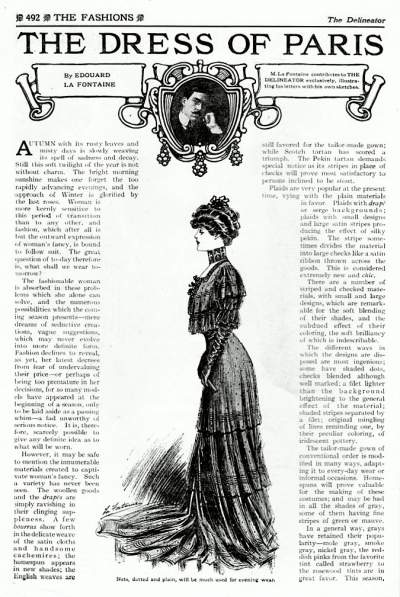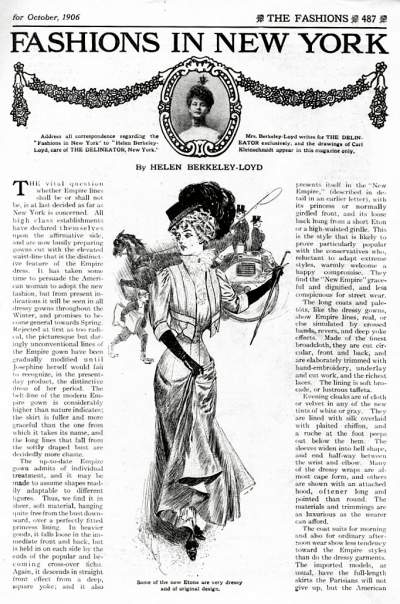The October 1906 issue of the Delineator magazine presents us with two separate articles; one is called “The Dress of Paris,” written and illustrated by Edouard La Fontaine, and the other is “Fashions in New York,” written by Helen Berkeley-Loyd with drawings by Carl Kleinschmidt. In this entry, I’ll present them both so you can see the differences and similarities first-hand from people who actually lived surrounded by these fashions.
The Dress of Paris
The beginning of this article on the styles of Paris brings to us a bit of the melancholy and beauty that we often associate with a distant Paris of the past. However, after a rather wistful introduction, the author turns to more factual bits of information on what the fashionable Parisian of his day was wearing. It seems that plaid was extremely popular:
“Plaids are very popular at the present time, vying with the plain materials in favor. Plaids with drape or serge backgrounds; plaids with small designs and large satin stripes producing the effect of silky pekin. The stripe sometimes divides the material into large checks like a satin ribbon thrown across the goods. This is considered extremely new and chic.”
As far as popular colors, all types of gray tints were still to be seen:
“In a general way, grays have retained their popularity – mole gray, smoke gray, nickel gray, the reddish pinks from the favorite tint called strawberry to the rosewood tints are in great favor.”
Now, let us cross the ocean and turn to New York City.
Fashions in New York
Here in New York City, we get right to the fashion talk. One of the things we find is that the gray colors so beloved in Paris are found here in New York, too, although it seems they are especially popular in evening wear:
“Evening cloaks are of cloth or velvet in any of the new tints of white or gray. They are lined with silk overlaid with plaited chiffon, and a ruche at the foot peeps out below the hem. The sleeves widen into bell shape, and end half-way between the wrist and elbow.”
Besides that, however, the Empire silhouette sounds like it was quite the thing that year.
“The vital question whether Empire lines shall be or shall not be, is at last decided as far as New York is concerned. All high class establishments have declared themselves upon the affirmative side, and are now busily preparing gowns cut with the elevated waist-line that is the distinctive feature of the Empire dress… Rejected at first as too radical, the picturesque but daringly unconventional lines of the Empire gown have been gradually modified until Josephine herself would fail to recognize, in the present-day product, the distinctive dress of her period.”
You may of course click on the articles scanned above to read in more detail about the styles of that year.





{ 0 comments… add one }